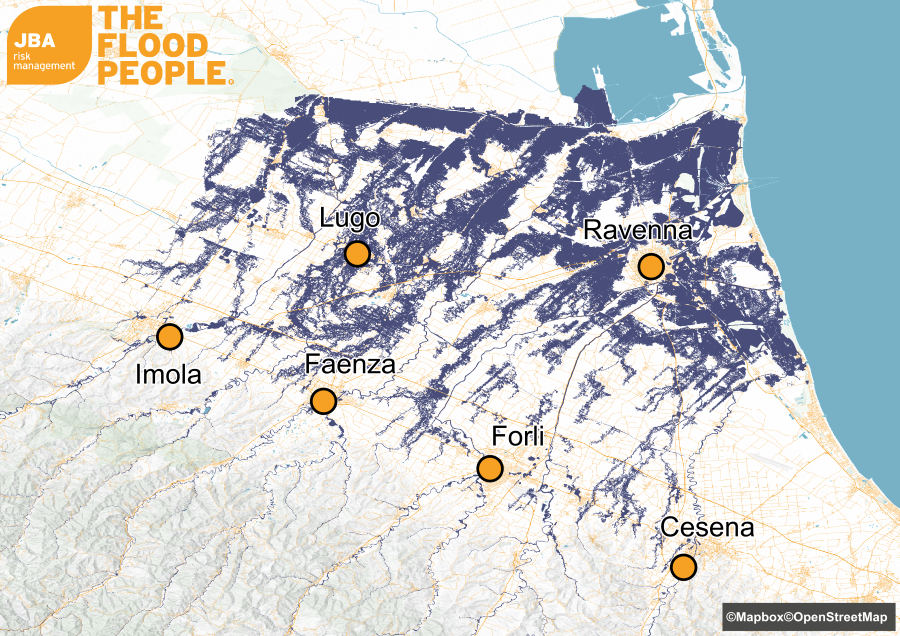Flooding devastated Italy's Po Valley in May, affecting Imola,Cesena, Forli, Faenza, Ravenna, Lugo, and surrounding areas (Figure 1).

Source : JBA Risk Management Ltd
The region was hit by two events, the first between May 2 and 3, and the second between May 15 and 17. The second was the most severe, with an average of 200mm of rain falling across the region in a 36-hour period, and some areas recording over 500mm. There were 15 fatalities, over 36,000 people evacuated, at least 376 landslides, and 714 closed roads (445 totally, and 259 partially)[1]. The regional government has provided a provisional estimate of €5 billion (U.S.$5.4 billion)[2] in economic damage, but this figure is expected to change as the full extent of the disaster materializes.
200mm average rain falling across the region in a 36-hour period, and some areas recording over 500mm.
15 fatalities.
36,000+ people evacuated.
376 landslides at least.
714 closed roads (445 totally, and 259 partially).
$5.4billion in economic damage as provided by regional government as a provisional estimate.
In the past few years, Emilia-Romagna has been affected by several destructive flood events, including significant river flooding (e.g. Secchia and Panaro Rivers in January 2014, Enza River in December 2017, Reno River in February 2019, Idice River in November 2019), flash-flooding in mountainous areas (e.g. Alta Val Nure in September 2015), and intense rainfall-induced flooding in urban areas (e.g. Rimini in June 2013).
According to the Italian Institute of Environmental Protection and Research, around 63% of businesses and homes in Emilia-Romagna are located within the 1-in-100 year flood zone. Moreover, the region plays a crucial role in the Italian economy, contributing more than 40% of Italy’s Gross National Product[3].
Although Italy is a flood-prone country and regions like Emilia-Romagna have high exposed value, the insurance penetration is lower than that of other developed European countries. Non-life insurance penetration in Italy was 1.9% of GDP in 2021. In comparison, the rate was 2.3% in Germany, 2.9% in Spain, 4.0% in France, and 7.4% in The Netherlands. If motor liability insurance (compulsory everywhere) is excluded, the gap in non-life premiums between Italy and other European countries is even wider[4].
Academic research indicates that flood risk in the Po Valley is changing due to two main factors; First, climate change is resulting in the intensification of extreme hydrological events, which meteorologists have attributed to a change in the atmospheric dynamics in the Mediterranean area. Previously the majority of weather systems moved from east-to-west, but we are now seeing an increase in north-to-south systems. This results in more extreme precipitation events because there is a larger temperature and humidity gradient between North Africa and Northern Europe[5]. Second, there has been an increase in the number of people exposed to flooding due to land-use and land-cover modifications. The government of Emilia- Romagna has enabled a significant expansion of urban areas over the last four decades. During flood events, the man-made drainage network is increasingly overloaded due to the significant proportion of land that has been converted from agricultural to urban. At the same time, flooding has caused more significant damages due to the increase in exposure values[6],[7].
With most of the population expecting government support following natural disasters, rather than underying insurance, there is a need for the country to review how to improve resilience and reduce the burden on government finances. This is especially true over the coming decades when climate change is expected to increase the frequency and severity of flood events.
All statistics were correct at time of publishing.
| Title | File Type | File Size |
|---|---|---|
| Natural Catastrophe Review January - June 2023 | 5.5 MB |
Dr Francesco Serinaldi is a Willis Research Fellow for the School of Engineering at Newcastle University. His areas of expertise are statistical analysis and stochastic modelling of hydro-environmental processes, and natural hazard risk assessment.
Chris is Director of Civil and Geospatial Engineering and Professor of Hydrology and Climate Change in the School of Engineering at Newcastle University.